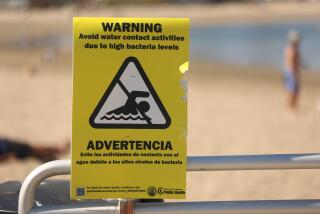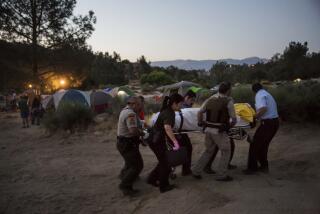‘Drowning Season’ Requires Vigilance : Uniform Pool-Safety Code Needed to Protect Toddlers
- Share via
Traffic is lighter on the freeways, the Orange County Fair has reappeared, and fleets of sailboats are riding the waves again, signaling a summer fully underway. But the dark side of a normally carefree time has appeared this year as well, symbolized by the gruesome nickname some emergency workers attach to summer: “the drowning season.”
Two weeks ago, two 13-year-old boys drowned during a church-sponsored swimming party and picnic in Fountain Valley. A friend said the two youths did not know how to swim. As happens often in such tragedies, apparently no one saw the teen-agers find their way from the shallow end to the deeper water of the pool.
Last week in Huntington Beach, a year-old girl drowned in a back-yard pool. Police said the girl’s mother was talking with someone at the front door of her home for less than five minutes. When she returned to the living room, she saw a sliding door was ajar and dashed outside to find her child in the pool.
The prevalence of pools and the mild weather that allows people to enjoy them year-round long has concerned health care workers and led to repeated campaigns for pool safety. Statistically, California pools are more dangerous to the very young than are automobiles.
Drowning remains the leading cause of fatalities among children ages 1 to 4, according to the Orange County Health Care Agency. After registering half a dozen deaths in 1991 and again in 1992, Orange County had 17 drownings of children under 5 last year. So far this year the number is three, but officials said the warmer summer weather make this a time when parents and caretakers of toddlers needed to be especially careful.
The Health Care Agency conducted welcome research on pool safety for young children for three years, helped by a state grant. The agency also is co-chair of the county Drowning Prevention Network, a coalition that includes the Children’s Hospital of Orange County, the Red Cross, the Orange County Trauma Society and other groups.
This year, the coalition’s much-needed education programs included a daylong May event at Anaheim Stadium in which about 700 people--parents, grandparents, day-care workers--were trained in cardiopulmonary resuscitation. In the evening, the organizers of the classes gave awards to three parents who used CPR to save their children from drowning.
A major message of the coalition is that parents cannot count on monitoring their children’s whereabouts to protect them from drowning. Most who drowned, or nearly drowned, were last seen in the house, the Health Care Agency reported. They were napping or playing or watching television. But they got out through a sliding door or behind parents unaware they were there.
The best prevention is no pool, but when there is one, it should be fenced off. Orange County cities should help here. Only a few have adopted suggested additions to local building codes requiring new pools to have fences or other barriers. Other cities should follow suit or support a statewide building code amendment now being considered again in the Legislature requiring the barriers.
There are more than 100,000 swimming pools in Orange County. They make a stunning sight from the air, and are a pleasant asset on warm summer days. But the drownings of youngsters are tragedies that occur too often and that are preventable. Fencing and knowledge of CPR would help cut the death toll. They should be mandatory minimum steps for anyone with a pool.
More to Read
Sign up for Essential California
The most important California stories and recommendations in your inbox every morning.
You may occasionally receive promotional content from the Los Angeles Times.













